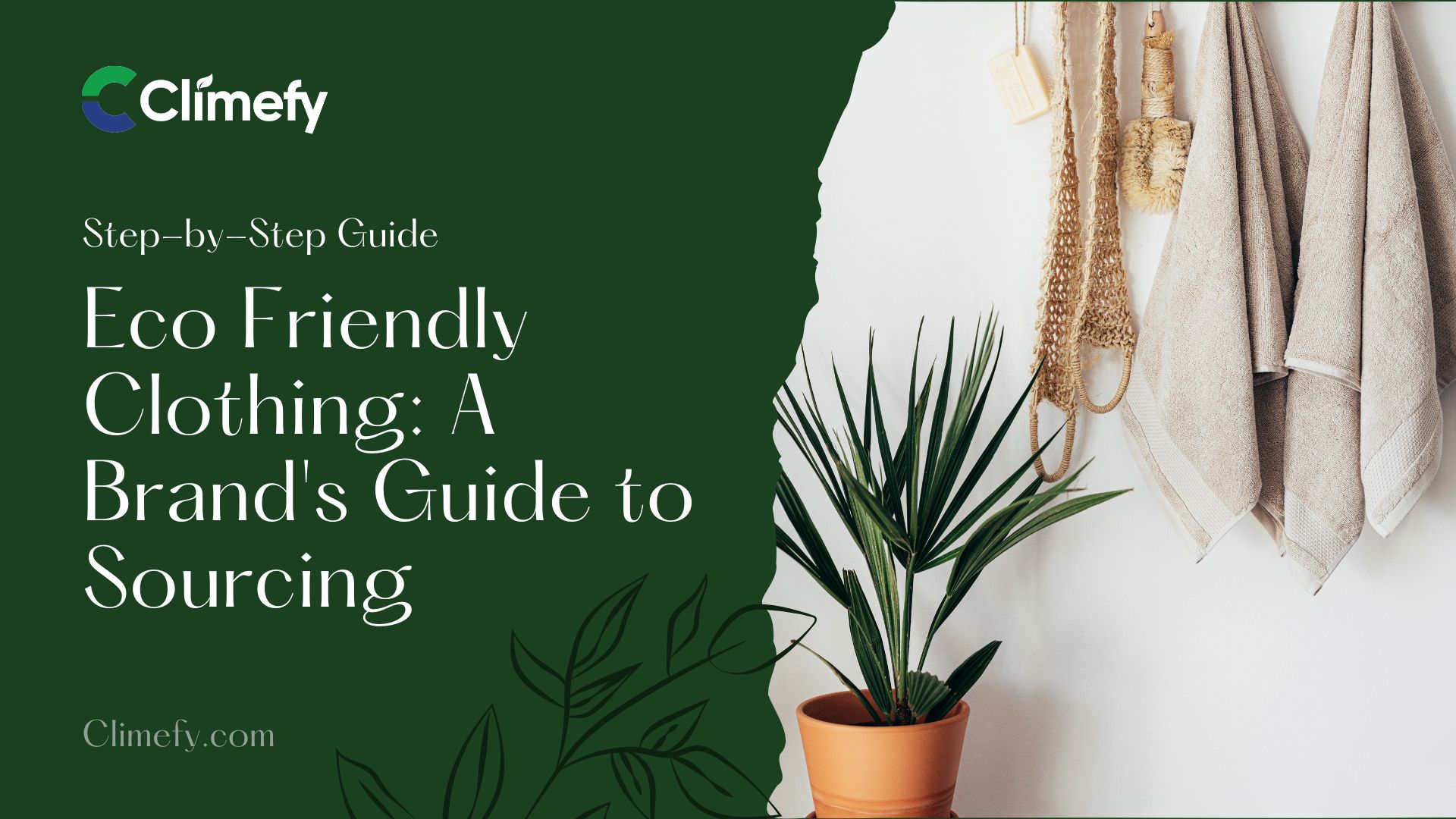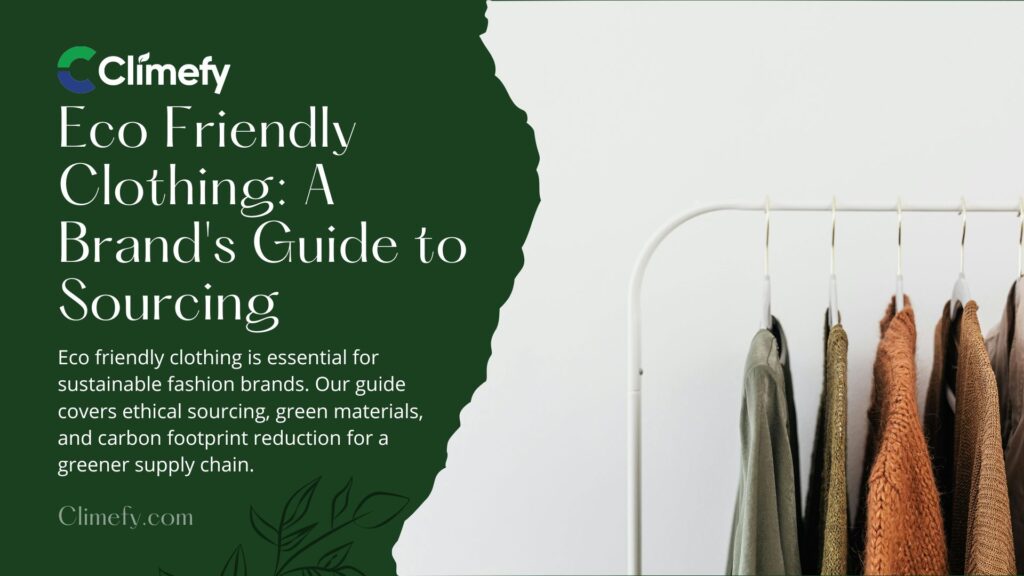

Eco friendly clothing is no longer a niche trend but a fundamental expectation for the modern, conscious consumer. For brands, transitioning to a sustainable fashion model is a complex journey that extends from raw material selection to end-of-life garment management, demanding a meticulous approach to sourcing and supply chain transparency. You will learn the intricacies of building a responsible supply chain that aligns with both your ethical values and business objectives.
In this definitive guide, you will discover:
Read More:

The fashion industry is one of the world’s biggest polluters — but it’s also full of potential for positive change.
Here’s why sustainable clothing matters more than ever:
| Reason | Impact on the Industry |
|---|---|
| 🌍 Environmental Protection | Reduces textile waste, chemical pollution, and excessive water use. |
| ❤️ Ethical Labor Practices | Promotes fair wages, safe working conditions, and respect for garment workers. |
| 🔄 Circular Fashion Movement | Encourages recycling, upcycling, and clothing reuse instead of disposal. |
| 💚 Consumer Demand Shift | More shoppers are choosing eco fabrics over fast fashion — and they’re willing to pay more for sustainability. |
In short, going green isn’t just good for the planet — it’s smart for business. Brands embracing eco-friendly practices are winning trust, loyalty, and long-term growth.
When it comes to eco fabrics, not all materials are created equal. Some are naturally sustainable, while others are engineered to reduce waste.
Here are a few popular options you’ll find in ethical apparel today:
These materials form the foundation of eco-friendly fashion — helping brands lower their environmental footprint while offering comfort, quality, and style.
The modern shopper isn’t just buying clothes — they’re buying values. Today’s consumers care deeply about how and where their clothes are made. In fact, studies show that more than 70% of global buyers prefer to purchase from brands that prioritize sustainability and ethics.
This shift means that eco-conscious fashion is no longer a niche trend — it’s the new normal. Shoppers now read clothing tags, research brand ethics, and even call out companies that ignore sustainable practices.
Simply put, if your brand wants to stay relevant, it must align with this ethical fashion movement.
Going green isn’t just good for the planet — it’s smart business. Here’s how sustainability helps brands stand out:
| Benefit | Description | Long-Term Impact |
|---|---|---|
| 🤝 Builds Trust | Consumers are more loyal to transparent, ethical companies. | Strengthens brand reputation and customer retention. |
| 🌟 Differentiates from Competitors | Eco-friendly clothing gives you a unique story in a crowded market. | Positions your brand as a leader in ethical fashion. |
| 💰 Saves Money Over Time | Sustainable sourcing reduces waste and energy costs. | Builds a sustainable business model with higher long-term profits. |
A brand that invests in sustainability today invests in loyal customers tomorrow.
Fast fashion produces cheap clothing at lightning speed — and it’s destroying the environment in the process. Here’s the reality:
By contrast, brands that adopt eco-friendly and ethical production methods reduce waste, save energy, and create a cleaner, healthier planet for everyone.
While sustainable materials might seem expensive initially, they cut costs in the long run by:
A well-planned sustainable business model pays for itself — both financially and environmentally.
Investors and consumers alike are rewarding brands that act responsibly.
In short, when you go green, you don’t just make clothes — you make a difference that customers and investors can see, feel, and support.
Building a sustainable brand starts with what you use — the fabric. Choosing the right materials and partners can transform your fashion line from fast to forever. Let’s break down how you can responsibly source your next collection step by step.
The fabric you choose defines your brand’s environmental footprint. Selecting eco-friendly textiles means opting for materials that use fewer resources, last longer, and are kind to both people and the planet.
Here are some of the top sustainable fabrics every brand should know:
| Fabric | Why It’s Sustainable | Best For |
|---|---|---|
| Organic Cotton | Grown without pesticides or synthetic fertilizers; safer for farmers and soil. | Everyday wear, t-shirts, denim. |
| Bamboo Fabric | Grows rapidly with little water and regenerates naturally; soft and breathable. | Activewear, undergarments, loungewear. |
| Hemp | Naturally pest-resistant, needs minimal water, and strengthens with every wash. | Streetwear, bags, eco-denim. |
| Tencel (Lyocell) | Made from wood pulp using a closed-loop system that recycles 99% of water and solvents. | Dresses, blouses, and luxury wear. |
| Linen (Flax) | Biodegradable, durable, and requires fewer chemicals during cultivation. | Summer clothing, suits, and home textiles. |
| Recycled Polyester (rPET) | Created from post-consumer plastic bottles, reducing landfill waste and carbon emissions. | Sportswear, outerwear, accessories. |
Before finalizing materials, check for official certifications that guarantee eco-friendliness and ethical production:
These certifications ensure your sourcing aligns with ethical manufacturing and helps earn customer trust.
Even the best fabric isn’t truly sustainable unless it comes from an ethical supplier. Finding and verifying the right partner can make or break your brand’s sustainability journey.
Before partnering, dig deeper into what your suppliers claim:
You don’t need to start from scratch — several platforms specialize in sustainable textile sourcing:
These platforms help you find reliable eco fabric suppliers that align with your sustainability values.
Transparency isn’t optional anymore — it’s expected. Modern consumers want to know where their clothes come from and who made them.
A transparent supply chain allows brands to:
Technology can make supply chain visibility easier and more accurate. Here are some tools that leading sustainable brands use:
When you integrate such tools, your brand not only ensures ethical manufacturing but also strengthens its sustainable business identity — something today’s buyers truly value.
In a world where “eco-friendly” has become a buzzword, not every green label tells the full story. Many brands and suppliers claim to be sustainable — but only a few can back it up with real proof. That’s why verifying sustainability claims is one of the most crucial steps in building a truly ethical fashion brand.
Let’s explore how you can separate genuine efforts from clever marketing.
Greenwashing happens when brands or suppliers make false or exaggerated claims about being eco-friendly — often to attract conscious consumers without actually changing their practices.
Here’s a simple truth: a recycled label or a leafy logo doesn’t make something sustainable.
To avoid greenwashing, always look for:
The easiest and most reliable way to ensure sustainability verification is by checking certifications and audits.
Here’s what to look for:
| Certification | What It Ensures | Benefit to Your Brand |
|---|---|---|
| GOTS (Global Organic Textile Standard) | Verifies organic fiber content and ethical processing. | Guarantees organic integrity from farm to fabric. |
| OEKO-TEX Standard 100 | Tests textiles for harmful chemicals and toxins. | Ensures product safety and consumer trust. |
| Fair Trade Certified | Protects workers’ rights and fair wages. | Builds a socially responsible brand image. |
| Bluesign® | Checks for sustainable resource use and clean production. | Demonstrates strong environmental commitment. |
| SA8000 | Evaluates social accountability and labor practices. | Ensures ethical audits and fair treatment in factories. |
When sourcing suppliers, ask for valid certificates and audit reports. If they hesitate to share, consider it a red flag. Transparency is non-negotiable in ethical fashion.
Before signing any sourcing deal, dig a little deeper. These questions can reveal whether your supplier truly follows sustainable practices:
A genuine supplier will always answer openly — and even provide documents, reports, or photos to back their claims.
Even the smartest brands can fall for misleading tactics. Here are a few red flags to watch out for:
| Trap | What It Means | What to Do Instead |
|---|---|---|
| 🏷️ Misleading Labels | Words like “natural” or “eco” without proof. | Always ask for certification or traceability data. |
| 🌿 Vague Marketing Terms | “Sustainably made” or “eco-conscious” with no measurable actions. | Request specific metrics — like % of recycled fiber or carbon savings. |
| 🧵 Unverified ‘Eco’ Claims | No third-party verification, audits, or sustainability reports. | Trust only suppliers with recognized eco certification and regular ethical audits. |
In short, don’t let “green” words blind you — let the facts guide you. Sustainable fashion isn’t about perfect marketing; it’s about proven, transparent action.
Going green sounds inspiring — but let’s be honest, it’s not always easy.
Transitioning from traditional to sustainable sourcing comes with its own set of hurdles. However, the brands that take this leap often discover that the rewards far outweigh the initial costs.
Let’s break down the most common sustainable sourcing challenges and how to overcome them smartly.
The biggest myth about eco-friendly fashion is that it’s “too expensive.”
While the upfront costs of sourcing organic fabrics or implementing ethical production processes may be higher, the long-term payoffs make it worthwhile.
| Factor | Short-Term Cost | Long-Term Benefit |
|---|---|---|
| Sustainable Materials | Eco fabrics like hemp or Tencel can cost 10–20% more initially. | Lower waste, better durability, and premium pricing potential. |
| Eco-Friendly Manufacturing | Ethical factories may charge more due to fair wages and safety standards. | Builds trust, loyalty, and brand reputation. |
| Sustainability Audits & Certifications | Requires audits or third-party verification fees. | Opens doors to global partnerships and eco-conscious investors. |
Over time, sustainable sourcing reduces waste, lowers returns, and boosts customer lifetime value — creating a stronger, more resilient business model.
Another major challenge for eco-conscious brands is finding sustainable materials in bulk or at competitive prices.
Some eco fabrics are still in limited supply, especially in developing regions. This can slow down production or increase costs temporarily.
Practical tips to manage this:
As the global shift toward green fashion continues, sustainable fabrics are becoming more accessible every year — making this challenge easier to overcome.
Switching to ethical production isn’t just about new materials — it’s about a new mindset.
Your team needs to understand how to handle eco fabrics, minimize waste, and ensure quality at every step.
Common training needs include:
Though it may take time and resources, this shift creates a stronger internal culture and positions your business as a leader in responsible manufacturing.
You don’t have to go 100% sustainable overnight. Begin with:
This approach lets you test, learn, and scale without overwhelming your team or budget.
If navigating the world of green sourcing feels daunting, you’re not alone. Many successful brands rely on sustainability consultants or ethical sourcing agents to guide them through certifications, audits, and supplier selection.
These experts help you:
Collaborating with professionals ensures your sustainability journey is authentic, efficient, and profitable.
When it comes to sustainability, some fashion giants aren’t just talking — they’re taking bold action. These sustainable fashion brands prove that eco-conscious practices can lead to both profit and purpose. Let’s take a closer look at three inspiring eco clothing success stories that set the standard for the entire industry.
Few names are as synonymous with sustainability as Patagonia. This outdoor apparel brand has built its entire identity around environmental responsibility and supply chain transparency.
Here’s what makes Patagonia a true leader:
Patagonia’s success story:
By proving that sustainability and profitability can coexist, Patagonia transformed into a global role model for ethical outdoor fashion and transparent sourcing.
Luxury fashion and sustainability don’t always go hand in hand — but Stella McCartney is changing that narrative. Since day one, her brand has been built on cruelty-free, sustainable values.
What sets Stella McCartney apart:
Stella McCartney’s impact:
By proving luxury can be compassionate, she’s inspired countless brands to experiment with eco-friendly materials without compromising elegance or quality.
When it comes to denim, Levi’s has made remarkable strides in sustainability. As one of the most recognized names in fashion, the brand took responsibility for its environmental footprint and introduced innovative ways to conserve resources.
Levi’s key sustainability moves:
Levi’s success story:
By adopting smart innovation and transparency, Levi’s has evolved from a classic denim brand into a sustainable fashion pioneer — proving that even heritage companies can lead in eco-conscious transformation.
Each of these eco clothing success stories shows that sustainability isn’t just a feel-good choice — it’s a winning business strategy. Whether through transparency, innovation, or conservation, these brands prove that ethical practices can create loyal customers, stronger reputations, and lasting change.
When it comes to planet-friendly materials, not all fabrics are created equal. The most eco-friendly options are those that use less water, fewer chemicals, and renewable resources.
Top picks from the sustainable fabric list:
Organic cotton: Grown without pesticides or harmful fertilizers.
Hemp: Naturally resistant to pests and needs minimal water.
Linen (flax): Biodegradable and durable.
Tencel™ (Lyocell): Made from responsibly sourced wood pulp.
Recycled polyester: Gives plastic waste a second life.
These fabrics not only reduce environmental impact but also promote better soil health and cleaner waterways.
Starting small is the key! You don’t have to overhaul your entire supply chain overnight. Instead:
Begin with one product line using eco fabrics.
Work with ethical suppliers who can verify their practices.
Ask for certifications (like GOTS or OEKO-TEX) before placing large orders.
Build relationships with local artisans or regional manufacturers who use sustainable methods.
Sustainability is a journey — and small, consistent steps matter just as much as big ones.
Initially, yes — but only slightly. The higher cost often comes from ethical wages, better-quality materials, and responsible production. However, sustainable garments tend to last longer, look better, and reduce long-term waste.
If you’re a brand, investing in affordable eco fabrics (like organic cotton blends or recycled fibers) can balance both cost and conscience. In the long run, it’s not just cost-effective — it’s brand-effective.
The best way to avoid greenwashing is through eco supplier verification. Here’s how you can check:
Ask for certifications: Such as GOTS, Fair Trade, SA8000, or BSCI.
Request audit reports: Ethical suppliers are transparent about their manufacturing conditions.
Visit the factory (if possible): Or schedule a virtual walkthrough.
Check for traceability: Ethical suppliers can provide details on fabric origins and production methods.
Never hesitate to ask questions — a truly sustainable partner will welcome your curiosity.
Certifications help brands and consumers trust what’s truly “eco” and what’s just marketing. Some of the most respected ones include:
GOTS (Global Organic Textile Standard) – for organic fibers.
OEKO-TEX Standard 100 – ensures fabrics are free from harmful chemicals.
Fair Trade Certified – promotes fair wages and safe working conditions.
Cradle to Cradle Certified™ – focuses on circular design and recyclability.
bluesign® – ensures safe and sustainable textile production.
Having one or more of these labels is a strong indicator that your supplier follows ethical fashion sourcing standards.
Sustainability isn’t about perfection — it’s about progress. Whether you’re a small designer or a growing brand, choosing better fabrics, verifying suppliers, and understanding certifications can make your fashion label part of a global movement toward responsibility and respect for the planet.